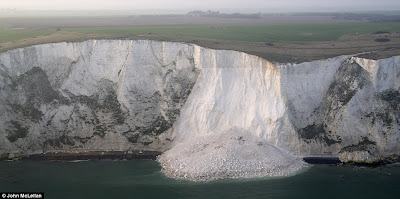(Photograph taken from the March 2012 collapse of the White Cliffs of Dover. The Cliffs remain white because they continually crumble and expose new rock.
http://www.dailymail.co.uk/news/article-2114912/White-Cliffs-Dover-Thousands-tons-chalk-crash-sea-large-section-collapses.html)
Frost weathering causes the Cliffs' collapses. An example of physical weathering, frost weathering causes rock fractures and breakage. Both the 2001 and 2012 collapses occurred during cold winter seasons and 2012's March collapse "has been blamed on February's chilly weather. Rain has been absorbed by the chalk and has then expanded as it freezes" (http://www.dailymail.co.uk/news/article-2114912/White-Cliffs-Dover-Thousands-tons-chalk-crash-sea-large-section-collapses.html).
(Circle above and yellow line represent ground that absorbs rain water.
(Rain water absorbed in ground above the Cliff freezes in cold winter months. The frozen water exerts force on the rocks of the Cliff and crumbles.
(Rock crumble resulted from frozen water expanding within Cliffs' chalk and caused collapse.
Although frost weathering is the main reason for the Cliffs' collapses, joints and other weathering processes help cause rock breakage and fracture. None of my sources mentioned joints in rocks, but frost weathering only occurs where joints exist.
(Three vertical lines within the yellow circle illustrate joints in the Cliff. The Cliffs' many joints absorb water deep in the rocks, causing major collapse when the water freezes along and in the Cliff.
I suspect root pressure from grass on and atop the Cliff filled joint fractures and broke sections of rock. Plant roots did not cause the same damage and rock crumble as frost weathering, but did help expand rock fractures along the Cliff. I hypothesize the grass roots growth and eventual rock breakage helped frost weathering damage the Cliffs.
(Much grass resides on the ground atop the Cliffs and the sides of the Cliffs. Grass roots help cause rock fracture and rock breakage.)
(More grass on and above Cliffs.)
(Grass all along the Cliffs of Dover, helping break rock from root pressure.)
(Shrubs and trees growing atop the Cliffs. A likely hotspot for root pressure and rock breakage.
Images courtesy of: http://www.dailymail.co.uk/news/article-2114912/White-Cliffs-Dover-Thousands-tons-chalk-crash-sea-large-section-collapses.html)
Along with weathering, the Cliffs erode about a half inch each year. The movement and transport of weathered material 10-20 million years ago affected County Kent's "major geographical features...a series of ridges and valleys...the results of erosion of the Wealden dome."
(View of a ridge and valley across the Kent Weald. http://en.wikipedia.org/wiki/File:WealdfromDowns.JPG)
The Wealden dome formed during Alpine movements and "consists of an upper layer of Chalk above successive layers of Upper Greensand, Gault Clay, Lower Greensand, Weald Clay, and Wealden sandstone." Ridges and valleys formed because "the exposed clay eroded faster than the exposed chalk, greensand, or sandstone" (http://en.wikipedia.org/wiki/Kent).
(A detailed look at Weald's layers:
- Chalk: white, porous sedimentary rock and a form of limestone
- Greensand: greenish colored sediment sandstone
- Gault Clay: a stiff compact clay soil
- Weald Clay: Cretaceous sedimentary rock
Sources:









